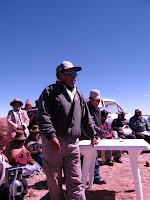
When I lived in Riverdale-On-Hudson, yes it's part of the Bronx, in New York City, I used to drive up to Morehouse Farm in the Hudson Valley. They had an open farm day and maybe still do. I recall driving up one autumn with my friend Margie and watching the sheep being sheared by a guy from New Zealand with an an accent and everything. How his back did it, I don't know. There was a excess of unhealthy spinal flexion going on as he simultaneously wrastled the animal and sheared with electric clippers. Morehouse Farm has had a website for a few years, so now I can go visit online.
Visiting this farm gave me my first taste of a primary addiction of choice for both knitting and spinning, merino wool.
Just before I left to move to SC, I found some of the lovely merino in my stash. It must have been frogged from another project, as there were MANY connecting knots in it. Nevertheless, I found a lace scarf pattern from Interweave that I had done before, and started in. This fir cone design is my favorite of the three scarves, as the pattern naturally forms a pointed border on either side.

I finished the scarf and being lazy of course, did not weave in the multiple ends. It had been gracing a buffet table in my front hall with the loose ends on the underside where no one could see. Two weeks ago, I decided to end that phase, and sat down and wove them all in. Then I washed and reblocked. It is now destined to be a holiday gift for a dear friend, who shall remain nameless in case she is lurking here.


 us.
us. 



















 Much of the track had been rebuilt since the floods in spring of this year (2010) and discarded tracks were seen along the
Much of the track had been rebuilt since the floods in spring of this year (2010) and discarded tracks were seen along the 

